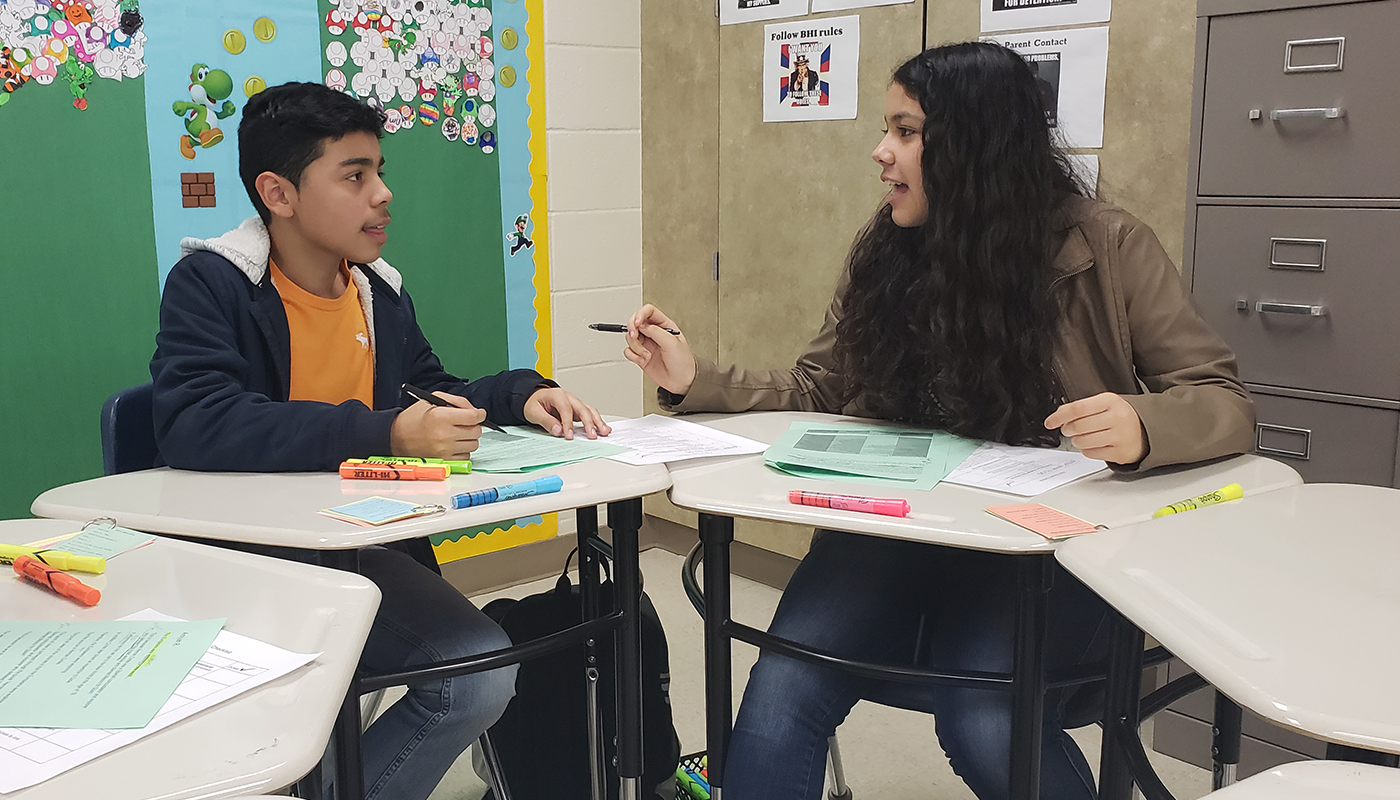
This is the first in a two-part guest post on using peer tutoring in the classroom, starting with a teacher’s perspective on the benefits for students. Next week, look for Catherine Birch’s tips on how to prepare your students and classroom for peer tutoring.
“What evidence do you have that supports your claim?”
“Can you make a connection with your hypothesis?”
“What data did you collect that supported your hypothesis?”
These may seem like questions that a teacher would ask a whole group of students during a lesson on the scientific method. But these questions are part of student-led conversations that I heard and recorded during a workshop in my 7th grade classroom on identifying patterns and interpreting data.
This demonstration of students asking quality questions and discussing ideas with peers is a product of peer tutoring, a learning strategy shown to increase academic achievement and improve relationships between peers.
Defining Peer Tutoring at Beverly Hills
On the campus of Beverly Hills Intermediate in Pasadena, Texas, peer tutoring can be described as students helping each other better access and understand subject content and develop cognitive skills, like gathering evidence to support a claim.
Peer tutoring has transformed our campus by providing space for students to share strategies; develop questioning techniques; use their voice; and thrive in a tight-knit community. These experiences not only prepare young people for success in careers and life, but also lay the groundwork to becoming strong collaborators and leaders.

Why Use Peer Tutoring?
Strategy Sharing Leads to Increased Access
In order to compete in today’s global society, learners need to be cognizant of when it’s time to shift their strategies. Knowing when a method just isn’t doing the trick, when to try something different, or even start a project from scratch has the power to make or break a student’s success in college and careers.
And who better to model this practice than a trusted peer who has previously mastered a skill and now has the capacity to share their trial and errors with the community? Not only do peers who tutor learn the content in a deeper way, but they can give a strong, positive influence to their classmates.
Fostering Student Voice
Before Summit Learning, I had accepted the idea that students in middle school just weren’t comfortable speaking in class. I thought I was doomed to have to work against the awkward pre-teen silence and refusal to participate in group discussions forever — until I began utilizing peer tutors during our intervention time.
Suddenly, students who had been virtually silent all year were reaching out and asking questions with increased confidence! Providing a structured time for student-to-student support in a small group setting allowed learners to find their voice and take the risk of speaking up and seeking help from their peers and teachers.
Not only do students hold each other accountable, but they offer reassurance to keep trying and learning.
Growth of Higher-Order Questioning
To elicit self-directed behaviors from students, I typically pose open-ended questions that aim at engaging learners in reflective thinking. The idea is that students will begin to mirror this technique and learn to question themselves when they encounter a challenging task or point of confusion. But sometimes in spite of teacher efforts, there is no comparison to a peer tutor’s natural talent of speaking the same language as their classmates.
It’s no surprise that young people are not only more willing to take advice from someone who is the same age, but that they ordinarily understand explanations from a peer better. So, why not utilize this valuable voice as a resource in a collaborative learning setting?
Once students have demonstrated mastery on a subject, they can ask relevant, logical questions that help their peers gain access to content and the ability to process new, challenging tasks. Students’ self-directed behaviors noticeably improve as they begin to imitate this behavior and learn which questions to ask themselves in order to solve a problem.
Development of Strong Community
Through peer tutoring, students learn to depend on each other as valuable resources. Not only do students hold each other accountable, but they offer reassurance to keep trying and learning. Peer tutoring provides an even playing field and is not constrained by student popularity or background.
The bond that emerges fosters genuine learning experiences that come without judgement. Students use this learning structure to help each other, rejoice in each other’s successes, and support one another when they encounter setbacks along the way.
In 2017-18, Catherine Birch received a Summit Learning Spotlight recognition for her outstanding work with students! You can read 2017-18 Spotlight stories here and find more information on the 2018-19 Spotlight theme and nomination process.

